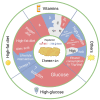The Role of Chemerin in Metabolic and Cardiovascular Disease: A Literature Review of Its Physiology and Pathology from a Nutritional Perspective
- PMID: 37447205
- PMCID: PMC10343651
- DOI: 10.3390/nu15132878
The Role of Chemerin in Metabolic and Cardiovascular Disease: A Literature Review of Its Physiology and Pathology from a Nutritional Perspective
Abstract
Chemerin is a novel adipokine that plays a major role in adipogenesis and lipid metabolism. It also induces inflammation and affects insulin signaling, steroidogenesis and thermogenesis. Consequently, it likely contributes to a variety of metabolic and cardiovascular diseases, including atherosclerosis, diabetes, hypertension and pre-eclampsia. This review describes its origin and receptors, as well as its role in various diseases, and subsequently summarizes how nutrition affects its levels. It concludes that vitamin A, fat, glucose and alcohol generally upregulate chemerin, while omega-3, salt and vitamin D suppress it. Dietary measures rather than drugs acting as chemerin receptor antagonists might become a novel tool to suppress chemerin effects, thereby potentially improving the aforementioned diseases. However, more detailed studies are required to fully understand chemerin regulation.
Keywords: cardiovascular disease; chemerin; metabolic disease; nutrients.
Conflict of interest statement
The authors declare no conflicts of interest. Figures with the credit “Created with BioRender.com”.
Figures




References
Publication types
MeSH terms
Substances
Grants and funding
LinkOut - more resources
Full Text Sources

